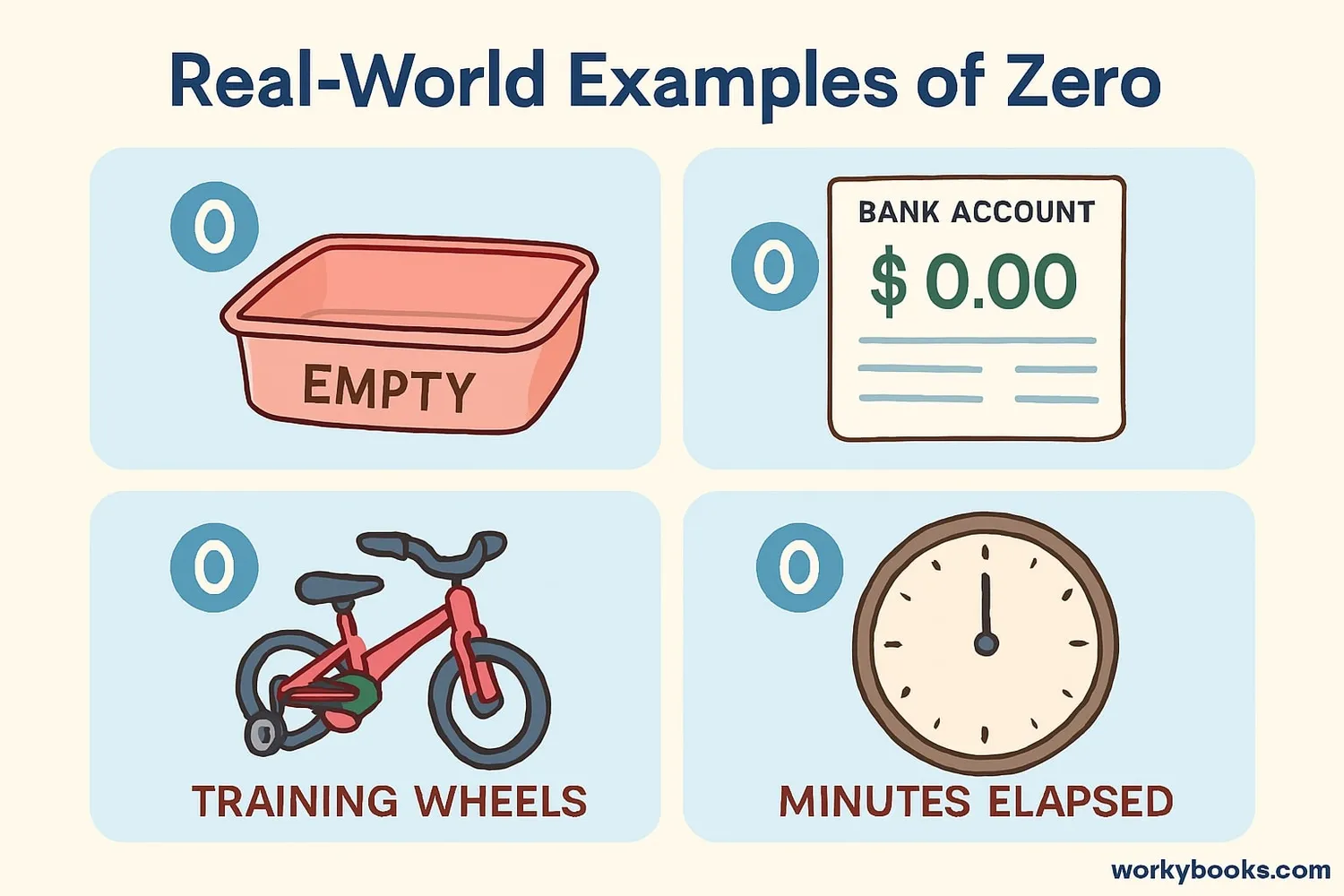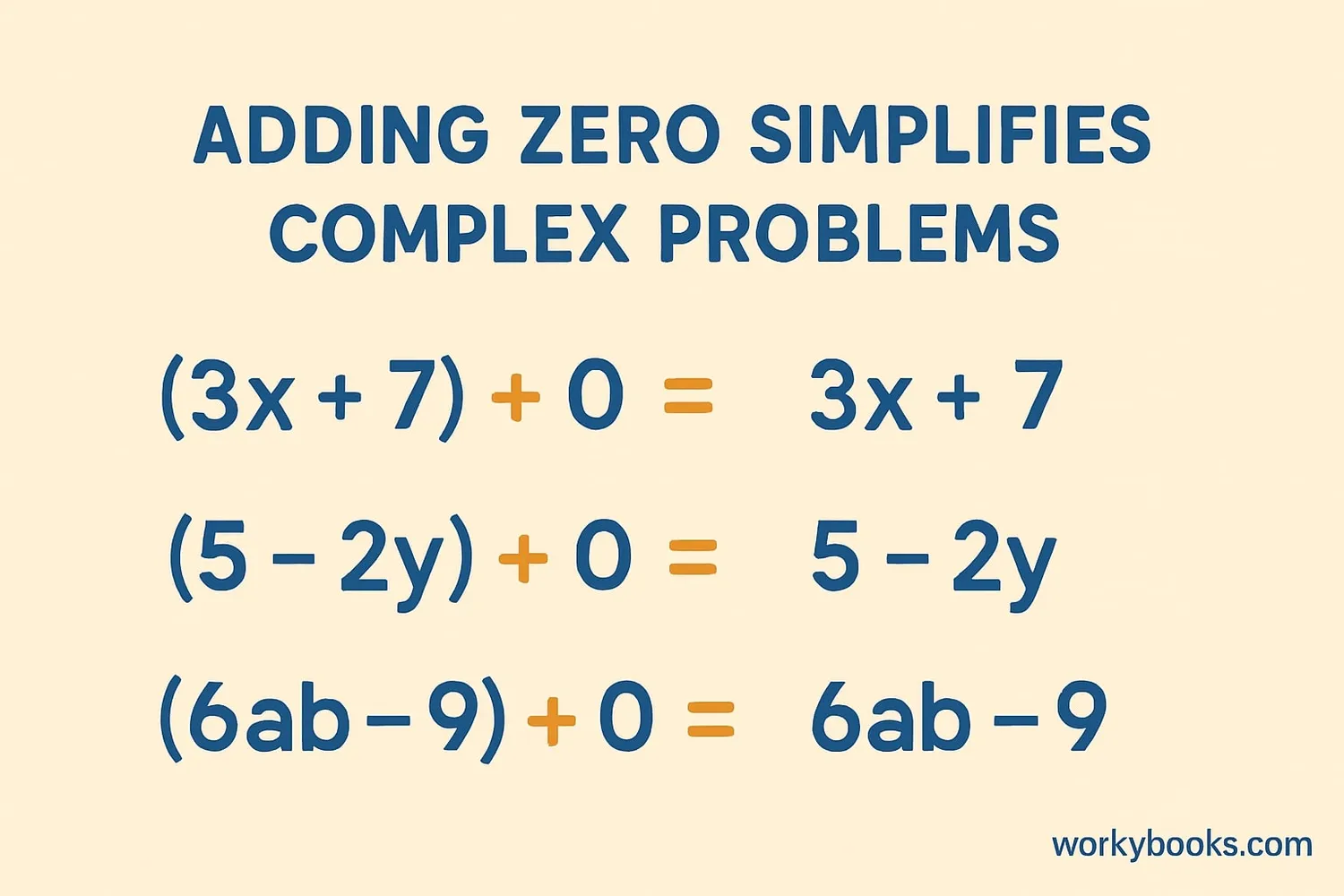Additive Identity Property of 0 - Definition, Examples, Quiz, FAQ, Trivia
Learn why adding zero doesn't change numbers with simple explanations and practice activities
What is Additive Identity Property?

The additive identity property is a special rule in math that says: when you add zero to any number, the number doesn't change.
Think of zero as a "nothing" number. If you have 5 cookies and add zero cookies, you still have 5 cookies! If you have 10 marbles and add zero marbles, you still have 10 marbles. This works for every number!
This property is called "additive identity" because:
- Additive means it's about adding numbers
- Identity means it doesn't change the number's identity
Key Concept
Zero is the only number that doesn't change other numbers when you add it. This makes it the "identity element" for addition.
Definition & Formula
The formal definition of the additive identity property is:
Additive Identity Property
Where "a" can be any number - whole numbers, fractions, decimals, or even negative numbers!
- Adding zero to any number gives you that same number
- Adding any number to zero also gives you that same number
- It doesn't matter which side the zero is on
Remember
Zero is the only number that works as an identity for addition. For multiplication, the identity is 1 (since a × 1 = a).
Examples of Additive Identity

The additive identity property works with all types of numbers. Here are some examples:
Whole Numbers
8 + 0 = 8
0 + 15 = 15
100 + 0 = 100
Fractions
½ + 0 = ½
0 + ¾ = ¾
⅔ + 0 = ⅔
Decimals
3.7 + 0 = 3.7
0 + 0.25 = 0.25
9.99 + 0 = 9.99
Negative Numbers
-5 + 0 = -5
0 + (-12) = -12
-3.5 + 0 = -3.5
Real-World Example
Imagine you have 7 marbles in a bag. If you add zero marbles, you still have 7 marbles. This is the additive identity property in action!
Why is Additive Identity Important?

The additive identity property might seem simple, but it's incredibly important in mathematics:
1. Solving Equations: It helps us solve equations. For example, in x + 3 = 3, we know x must be 0 because 0 is the only number that doesn't change 3 when added.
2. Placeholder in Large Numbers: Zero acts as a placeholder in numbers like 105 (which means 1 hundred, 0 tens, and 5 ones). The additive identity property ensures that adding 0 tens doesn't change the number.
3. Foundation for Algebra: This property is fundamental in algebra. It helps us understand that adding zero doesn't change expressions: (x + y) + 0 = x + y.
4. Mental Math: Knowing that adding zero doesn't change a number helps with mental calculations. For example, 45 + 0 is obviously 45.
5. Computer Science: In programming, zero often represents "nothing" or "off", and the additive identity property helps in many calculations.
Math Tip
When you see +0 in a math problem, you can ignore it because it won't change the answer!
Practice Quiz
Test your understanding with this 5-question quiz. Choose the correct answer for each question.
Frequently Asked Questions
Here are answers to common questions about the additive identity property:
Math Trivia
Discover interesting facts about zero and mathematical properties:
History of Zero
The concept of zero was first developed by ancient Indian mathematicians around the 5th century. The earliest known use of zero as a number dates back to 628 AD in the work of Indian mathematician Brahmagupta.
Zero in Different Number Systems
Not all number systems had zero. Ancient Romans didn't have a symbol for zero. The Mayan civilization had a zero symbol, but they used it only as a placeholder, not as a number itself.
Identity Elements
Different operations have different identity elements. For addition it's 0, for multiplication it's 1. For exponentiation, the identity is 1 (since a¹ = a). For function composition, the identity function is f(x) = x.
Zero's Importance
Zero is crucial for our number system. Without it, we couldn't have place value (like distinguishing 25 from 205) and modern mathematics, science, and technology wouldn't be possible.





